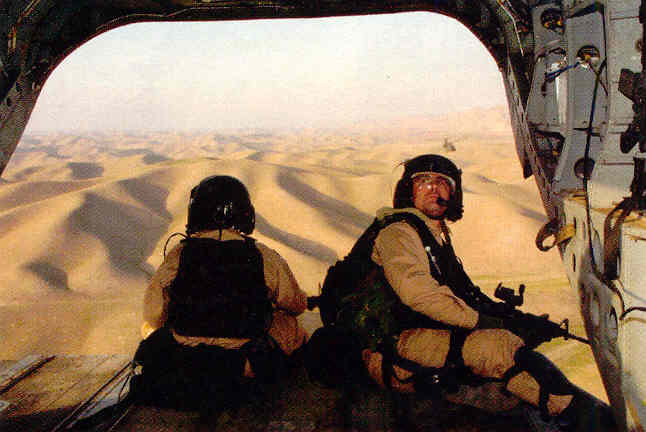26. BUSH (II) FUMBLES THE BALL

9/11 ... AND THE SEARCH FOR OSAMA BIN LADEN)
CONTENTS
 The evil hand of Islamic fundamentalism The evil hand of Islamic fundamentalism
strikes New York on 9/11 (2001)
 The world pays tribute to those who died The world pays tribute to those who died
on 9/11
 Going after al Qaeda ... and the Afghan Going after al Qaeda ... and the Afghan
Taliban
 The attempt to "democratize" The attempt to "democratize"
Afghanistan
 Taking more extreme measures Taking more extreme measures
 Problems with Pakistan Problems with Pakistan
 Bush attempts to line up support in the Bush attempts to line up support in the
rest of the world
The textual material on this webpage is drawn directly from my work
America – The Covenant Nation © 2021, Volume Two, pages 348-358.
THE CRUEL HAND OF ISLAMIC FUNDAMENTALISM STRIKES ON "9/11" (SEPTEMBER 11, 2001) |
|
On the morning of September 11 (9/11) of 2001, as
Bush was in a Florida classroom giving some publicity to his new
educational program, everything in American politics would take on a
new meaning and direction.
That fateful morning four commercial
airplanes were hijacked by nineteen al-Qaeda operatives. Two planes
flew into the New York World Trade Center buildings, eventually
bringing them down, with 2,600 office workers, police and firefighters
dying in the tragedy. Another one crashed into the Pentagon building,
killing 125 officers and workers there. And one flight (United Flight
93), alerted via cell phone by spouses that their hijacked plane was
undoubtedly headed for a strategic site in Washington, D.C., was
brought down near Shanksville in rural southwestern Pennsylvania by
very heroic passengers. All aboard were killed (40 passengers and crew
as well as the hijackers). But either the Capitol Building or White
House (the probable goals of the hijackers) was spared the fate of the
Twin Towers and the Pentagon.
The whole thing was a nightmarish shock,
not only to Americans but also to much of the world (many Muslims of
the Middle East, however, found much to celebrate in the event).
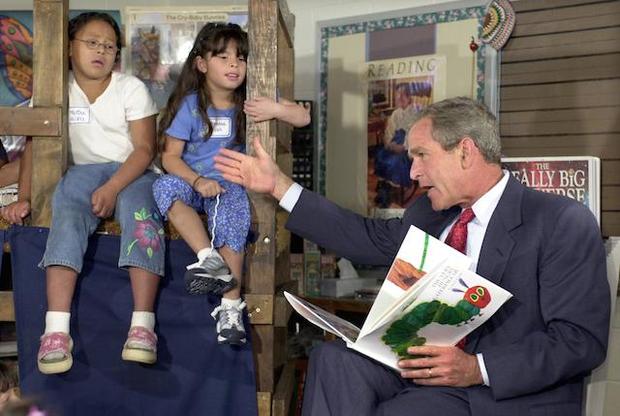
September 11, 2001 – Bush reading to
elementary students
as part of his effort to promote "No Child Left
Behind"
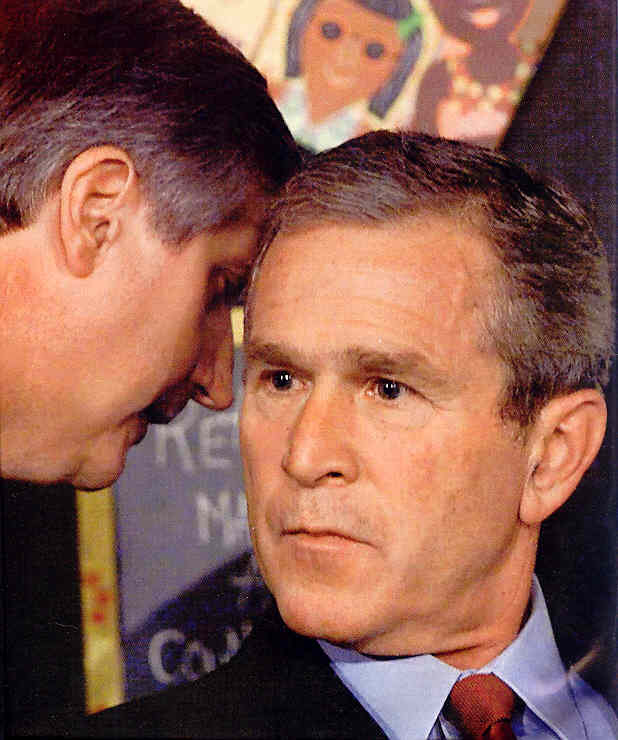
Pres. Bush being informed
by Chief of Staff Andy Card of the WTC tragedy
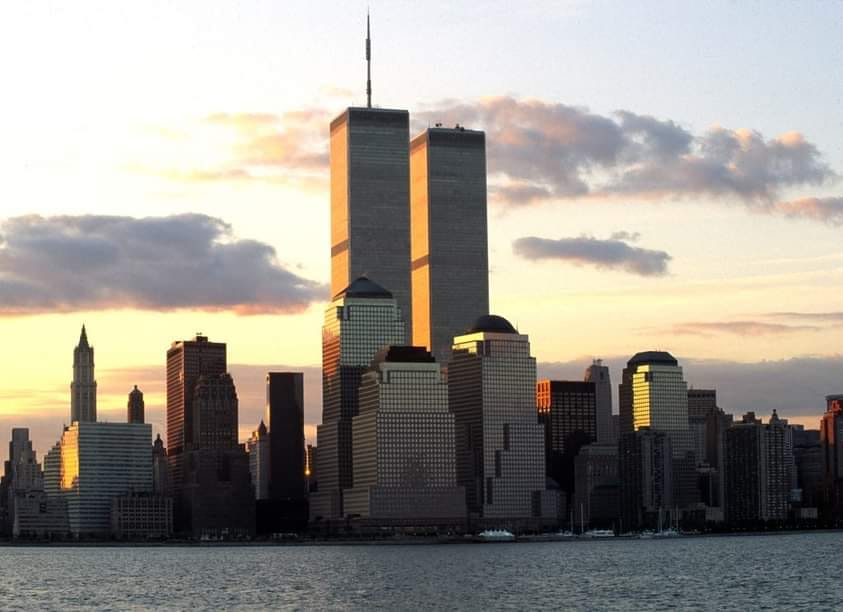
The Twin Towers stood as a sign of the city's greatness ... in service to the world
Then the jihadists decided that it was up to them to destroy just such a symbol
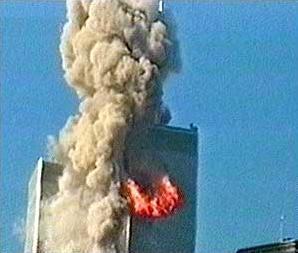
8:46 a.m. – American Flight
11 hits the North Tower
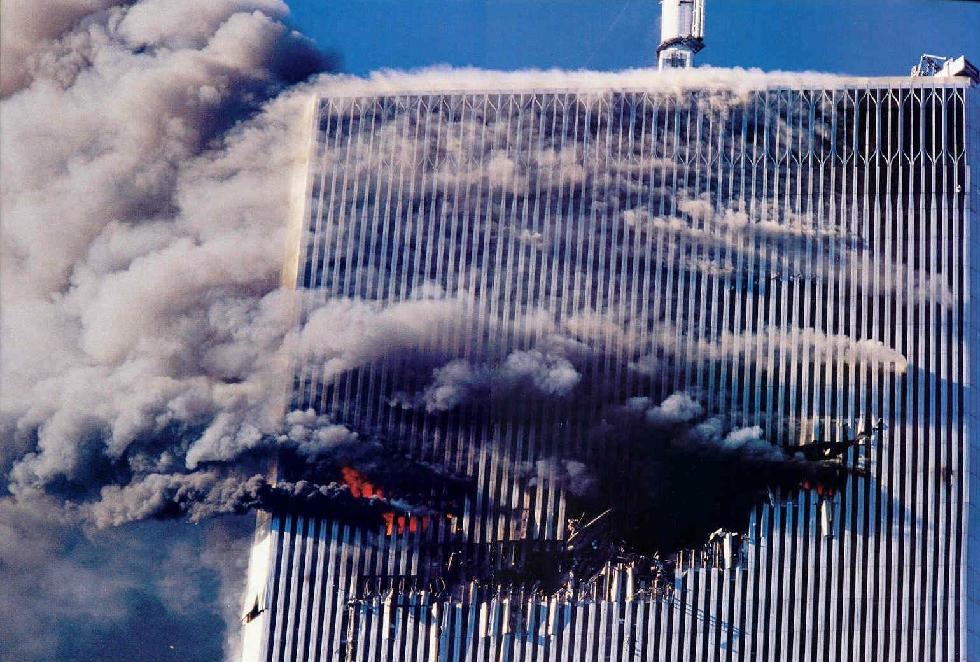
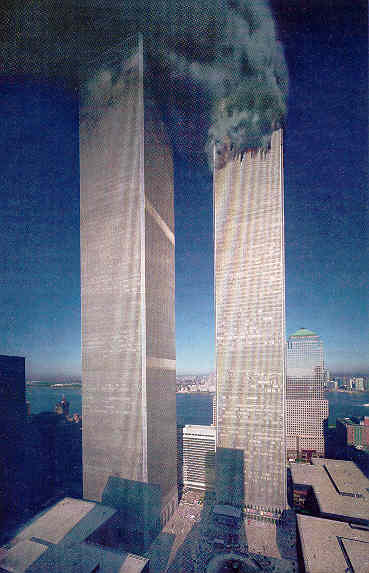
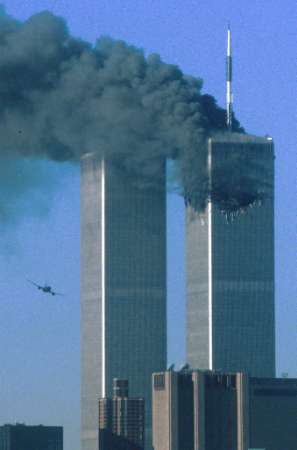 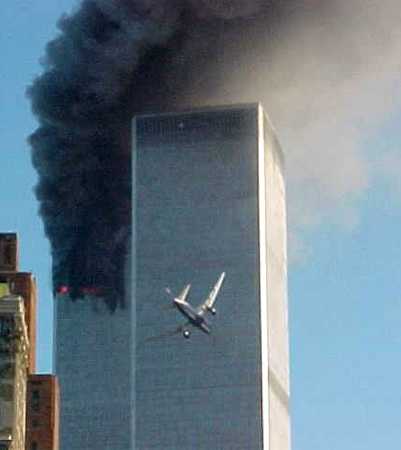 9:03 a.m. – United Flight
175 heads into the South Tower
9:03 a.m. – United Flight
175 heads into the South Tower
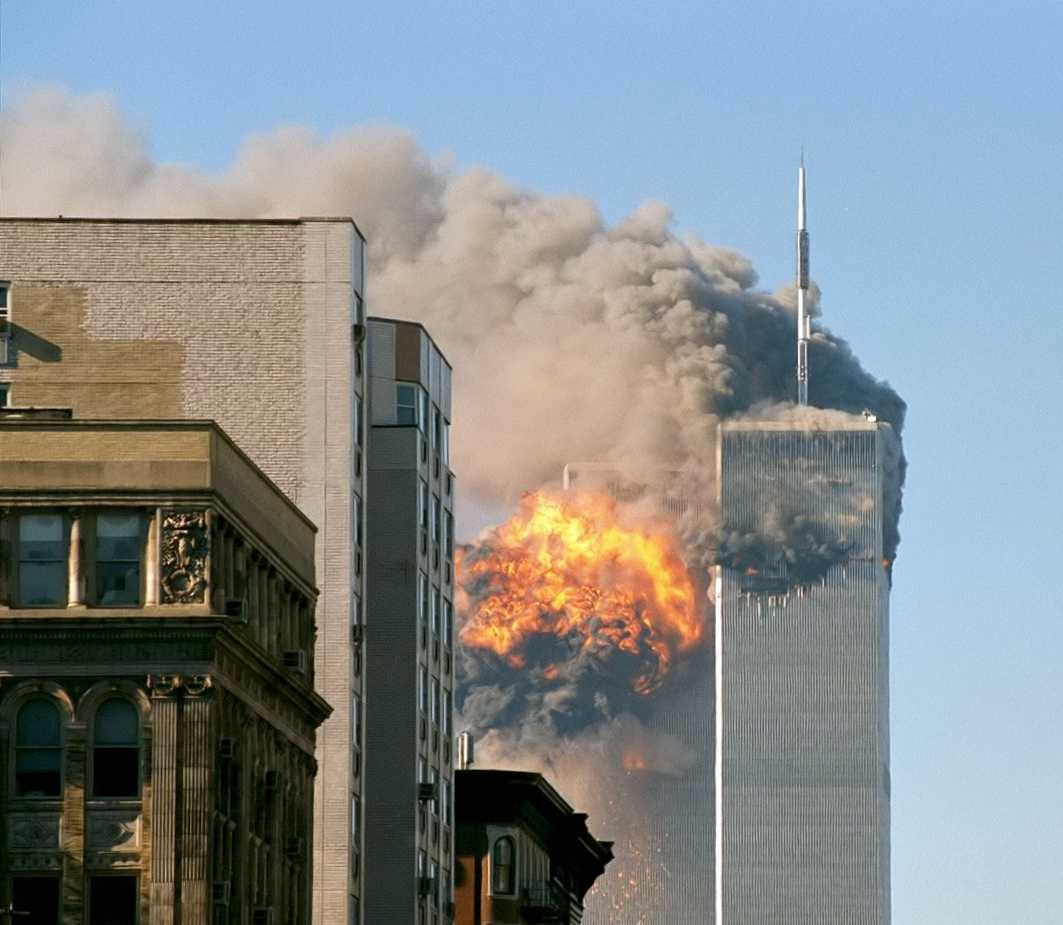
United Airlines Flight 175
crashes into the south tower of the World Trade Center
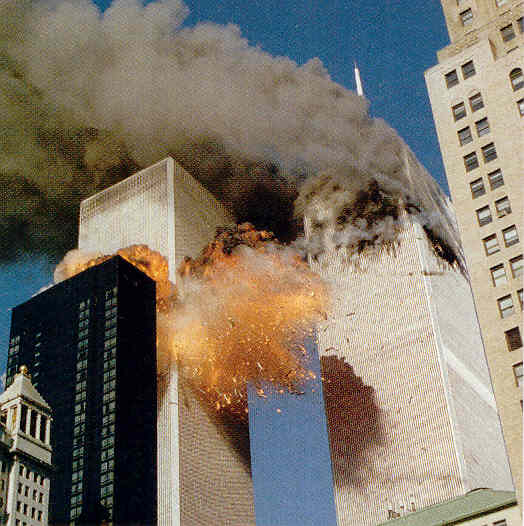
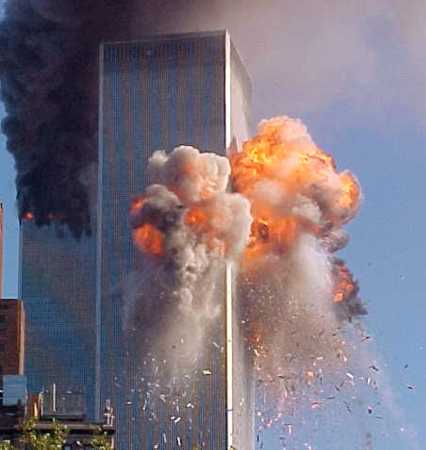
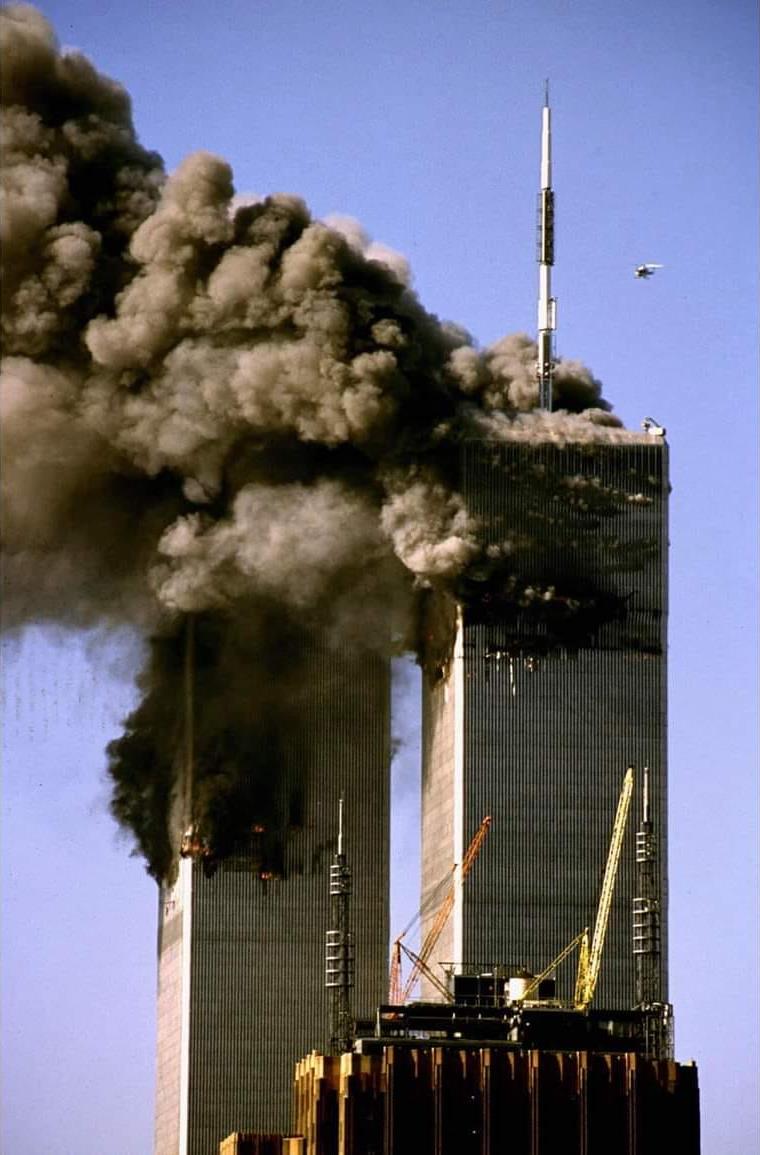
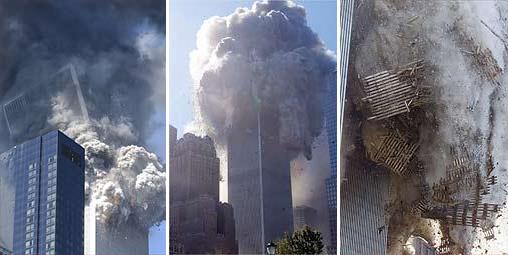
10:05 – the South Tower
collapses
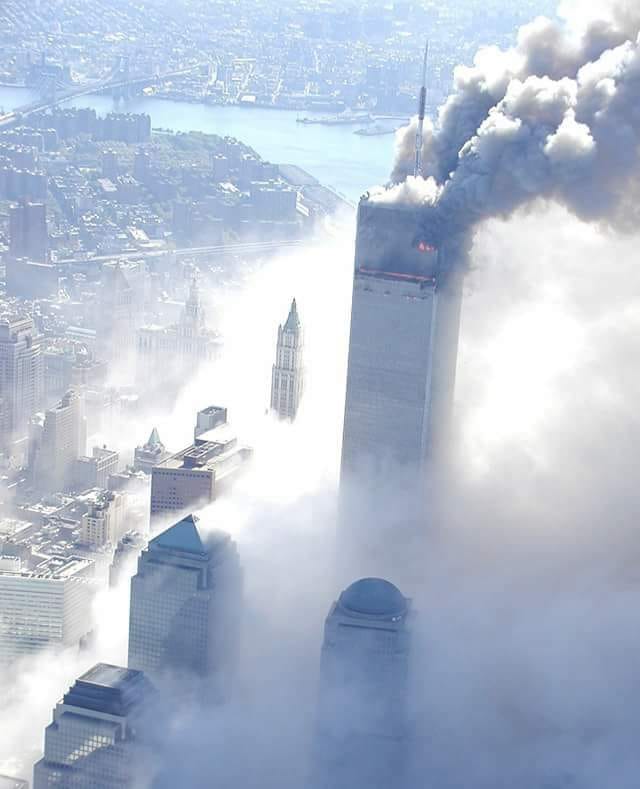
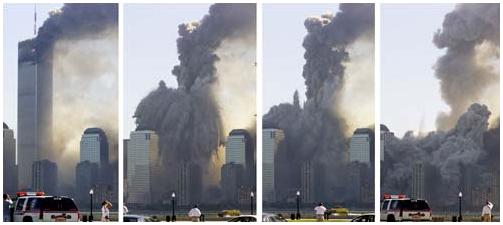 10:28 – the North Tower
collapses
10:28 – the North Tower
collapses
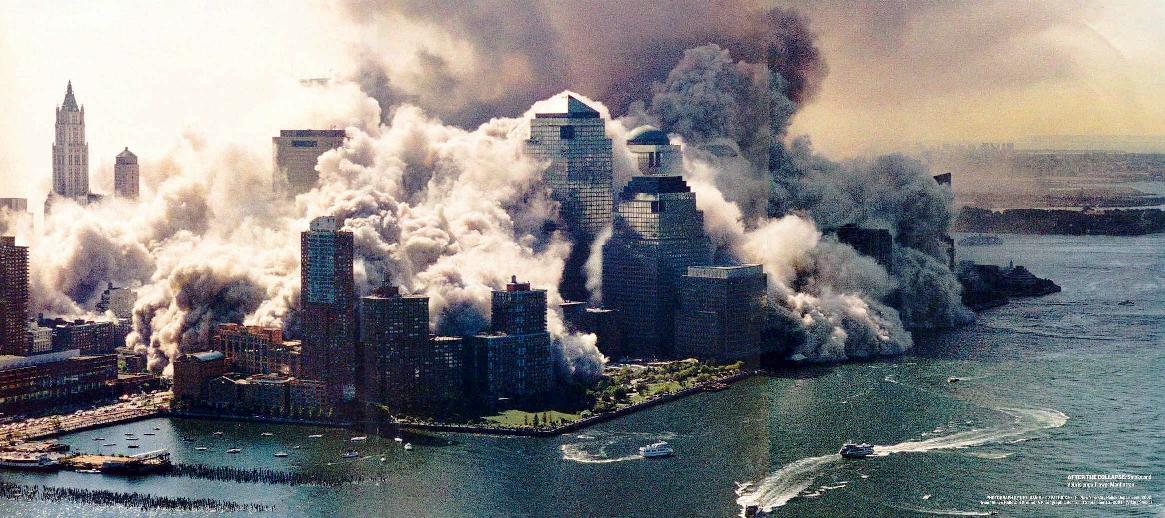
Det. David Fitzpatrick –
The New York City Police Department – 2002 [from "Above Hallowed Ground:
A Photographic Record of September 11, 2001" Viking Studio]
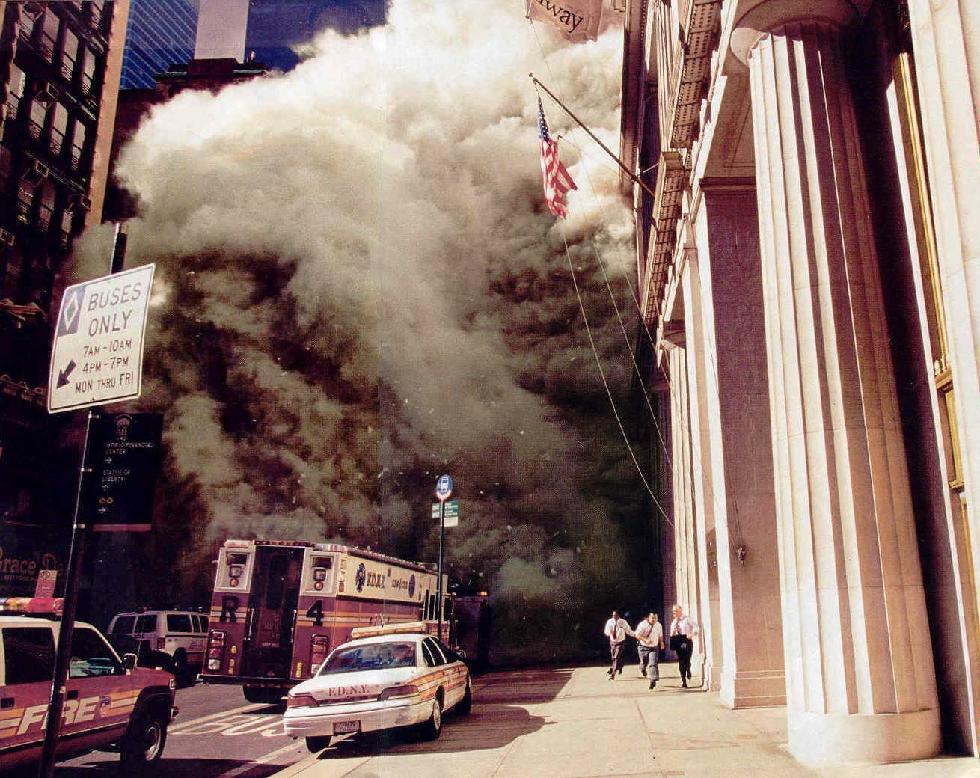
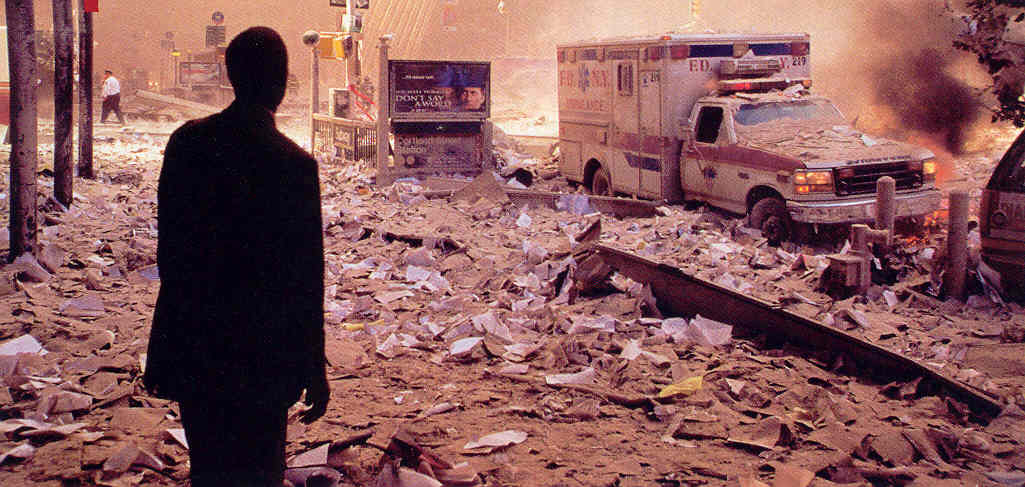
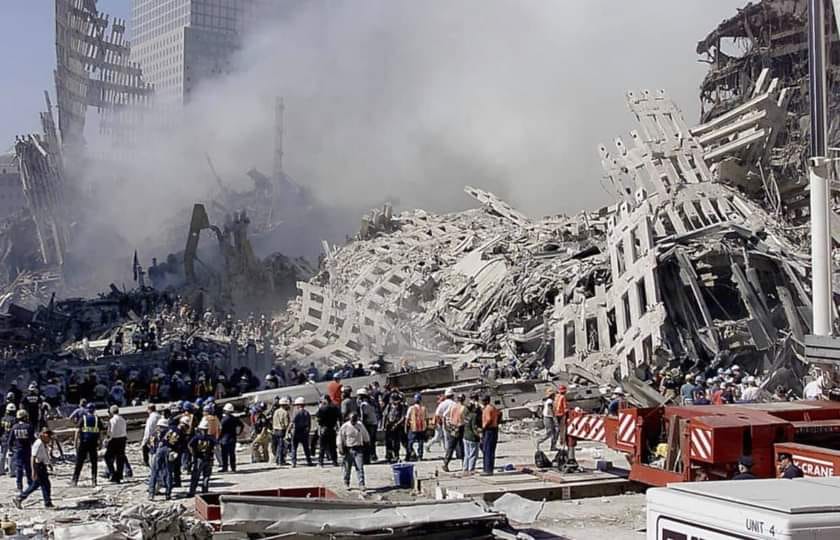
Surrounding buildings were also taken down by the collapsing towers
At 9:45 American Airlines
Flight 77 crashes into the Pentagon
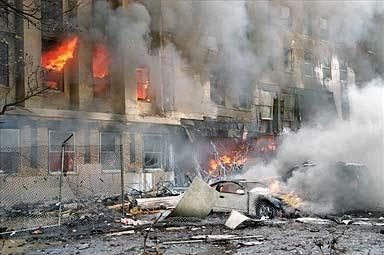 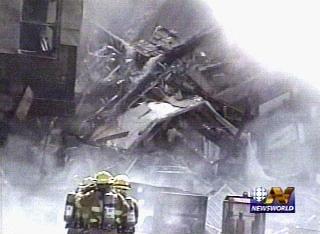
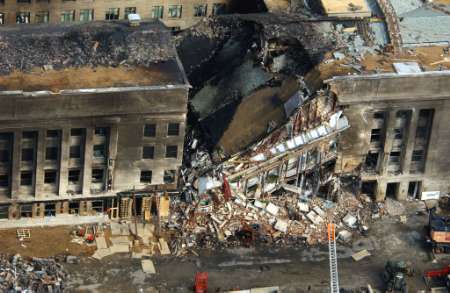
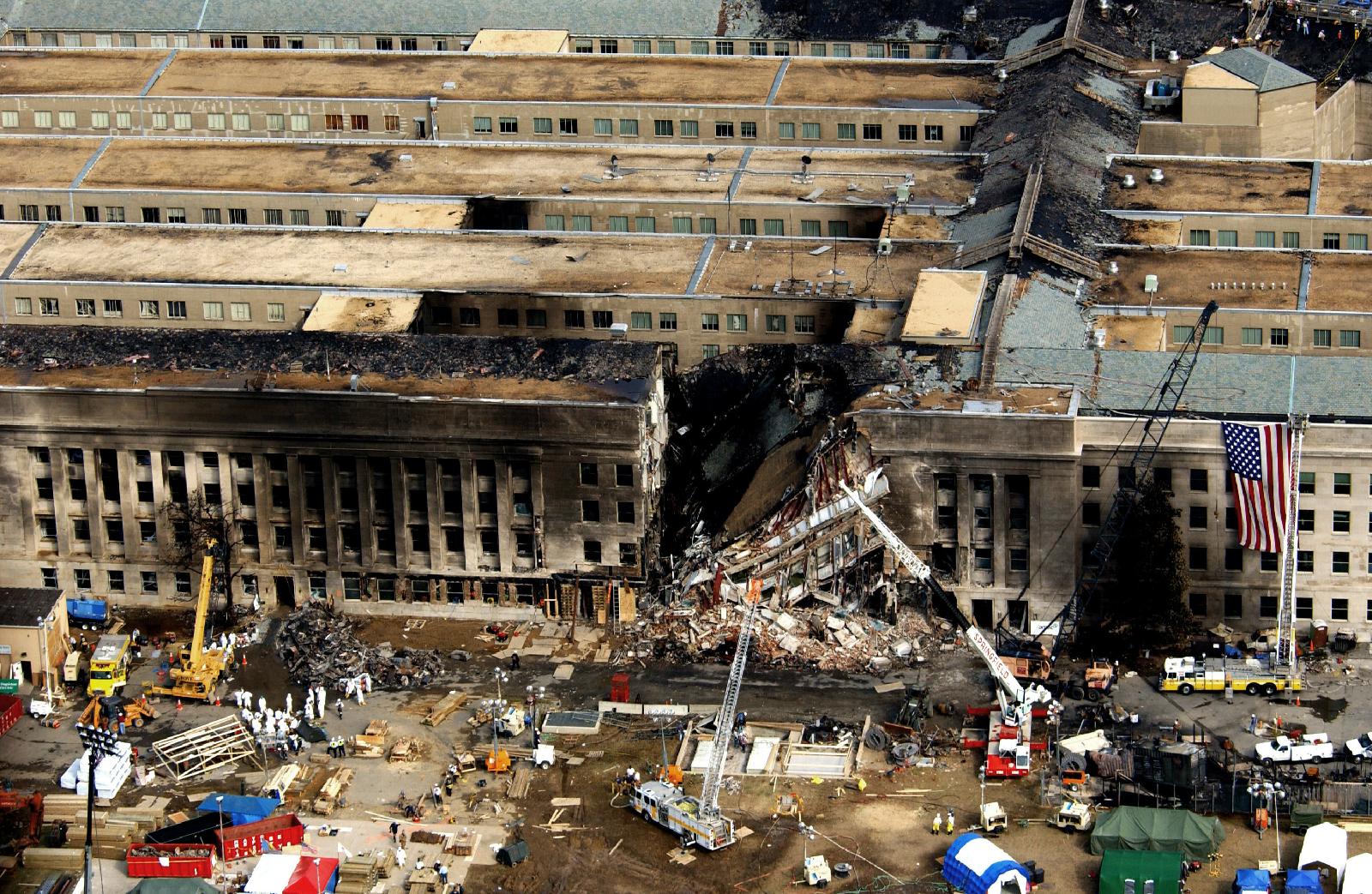
Aerial view of the Pentagon
Building located in Arlington, Virginia showing emergency crews responding
to the destruction
10:10 a.m. – United Flight
93 hijacked and turned toward Washington, D.C., crashes in a wooded area
in Stony Creek Township, Pennsylvania,
after passengers confront hijackers.
But mostly what remains
seems to be just a huge crater.
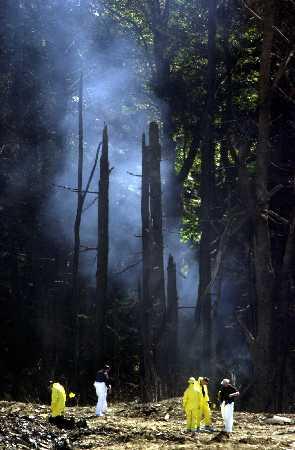 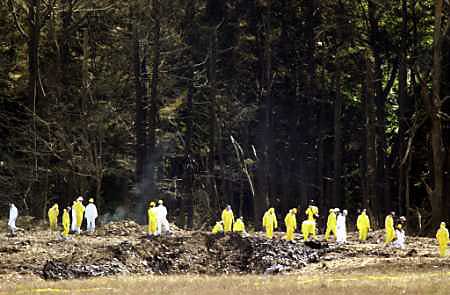 The aftermath of 9/11
The aftermath of 9/11
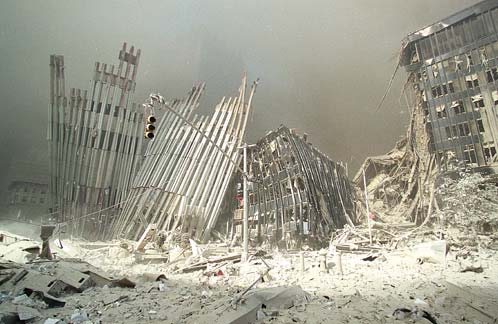 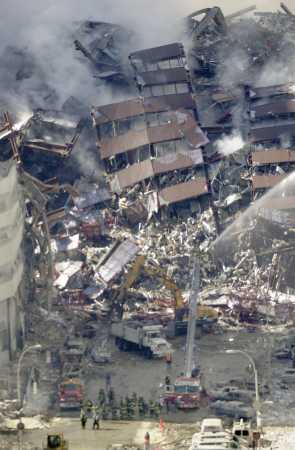 Aftermath of the collapse
at "Ground Zero"
Aftermath of the collapse
at "Ground Zero"
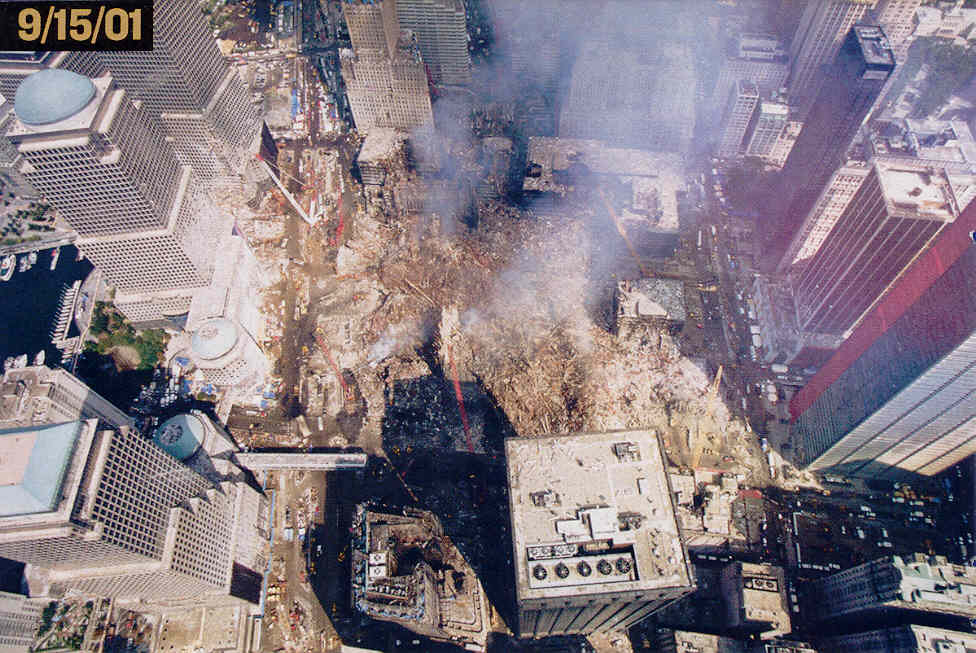
A view of the damage four days later
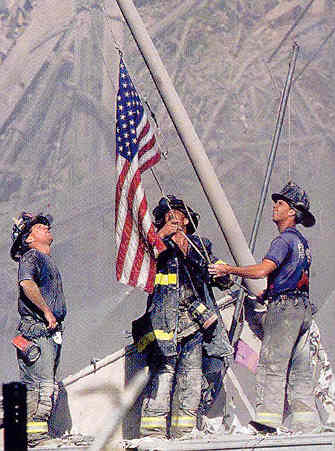
Three firemen raising the
American flag over "Ground Zero," September 11, 2001.
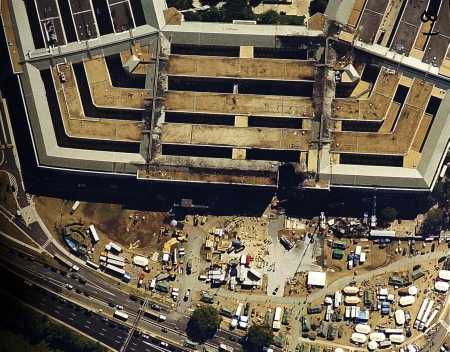 Cleaning up the
Pentagon
Cleaning up the
Pentagon
The hijackers: photos
released by the US Department of Justice
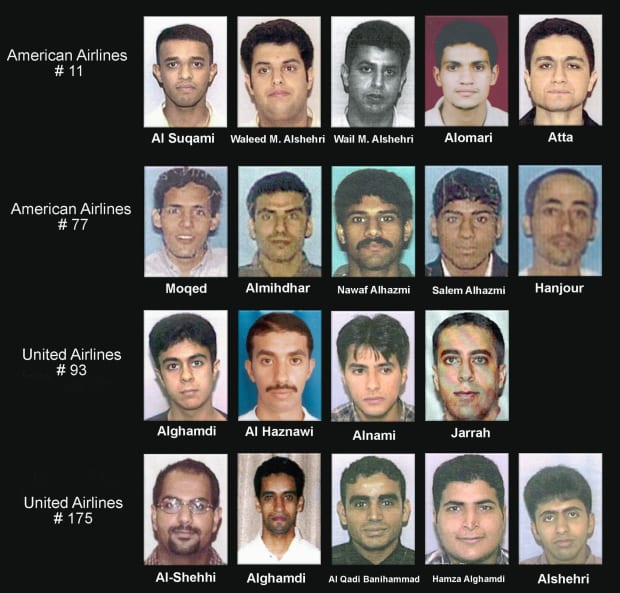
THE WORLD PAYS TRIBUTE TO THOSE THAT DIED ON
9/11 |
Pictures from Ars Technica
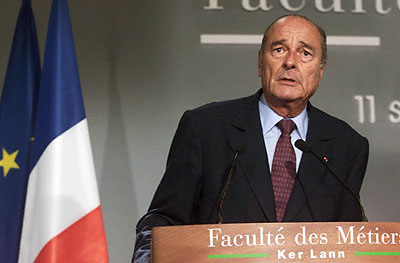
French President Jacques
Chirac announcing the tragedy
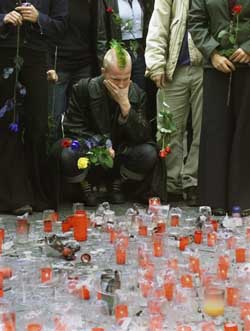 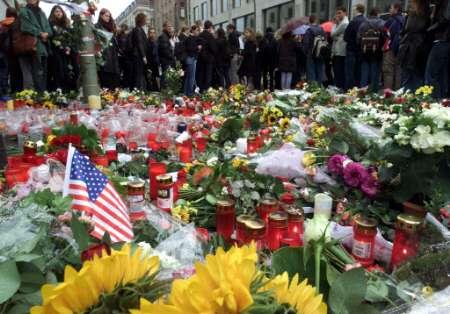 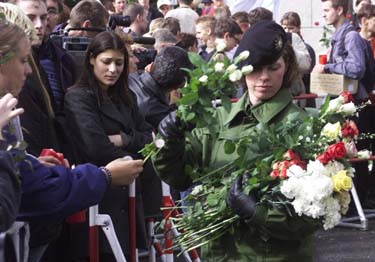 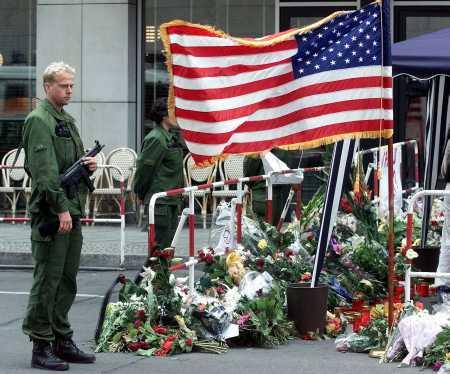
American Embassy, Berlin,
Germany
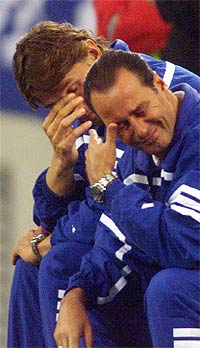 Players in a football
game in Germany, unwilling to compete after the attack. The EUFA ordered
the game to be played, so for most of the game
the players defiantly played
spiritlessly and uncompetitively.
Players in a football
game in Germany, unwilling to compete after the attack. The EUFA ordered
the game to be played, so for most of the game
the players defiantly played
spiritlessly and uncompetitively.
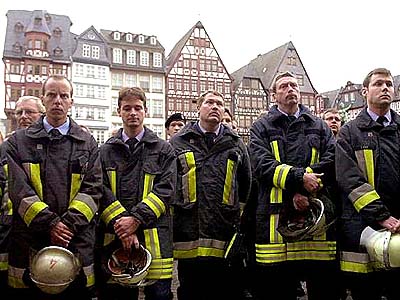
Frankfurt,
Germany

Munich, Germany
For more (many more) pictures of the world's reaction to the 9/11 attack
GOING AFTER AL-QAEDA ... AND THE AFGHAN TALIBAN |
|
Since 1993, the CIA had been watching al-Qaeda
training camps in Afghanistan and had developed a plan to go after the
leadership of this enemy organization. Ironically, this plan was more
or less finalized just prior to 9/11, but not in time to put the
Cabinet on alert to the dangers posed directly to the country by the
activities of al-Qaeda. Certainly however, the CIA recognized
immediately the al-Qaeda character of the attacks when they occurred on
that fateful day of 9/11.
The world stood in sympathy with the
United States. And quickly a large international coalition (from 42
different countries, most of them from NATO, and within NATO, mostly
the British) indicated a readiness to join with the Americans in
conducting an anti-terrorist drive into Afghanistan to destroy the
terrorists and their camps.
On September 20th, Bush went before a
joint session of Congress to announce to the Taliban authorities
governing Afghanistan that they must surrender the al-Qaeda
operatives or America (and much of the world) would do the job on its
own. But the Taliban refused to cooperate.
With this (expected) refusal of the
Taliban, the narrowly-defined surgical operation of taking out bin
Laden and the al-Qaeda organization took on a broader goal: to knock
out the Afghan Taliban as well, or any other regime giving sanctuary or
aiding in any way to such terrorists. According to what would
eventually be termed the "Bush Doctrine," going after the perpetrators
of the 9/11 hit was now expanded to liberating all of Afghanistan from
the tyranny of all Muslim fanatics, including the Taliban, who had
tried to pull the country back into the Middle Ages.
This of course would make the venture
something more than just an exercise in enacting justice on the
criminal perpetrators of the 9/11 tragedy. The Bush Doctrine would draw
America into the much, much larger challenge of nation-building (at
first just Afghanistan), the very thing of which Bush had been so
critical of the Clinton Administration. And Afghanistan, as wildly
diverse and as hostile as the various groups making up the country
happened to be, would make nation-building a virtually impossible task
– as every government working out of Kabul had long known the matter to
be. Afghanistan was not a nation, had never been a nation, and would
never become a nation any time soon.
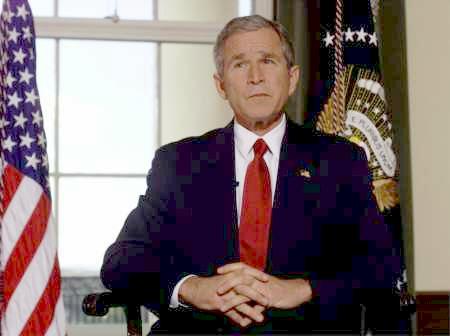 October 7, 2001 – President
Bush announces invasion of Afghanistan
October 7, 2001 – President
Bush announces invasion of Afghanistan
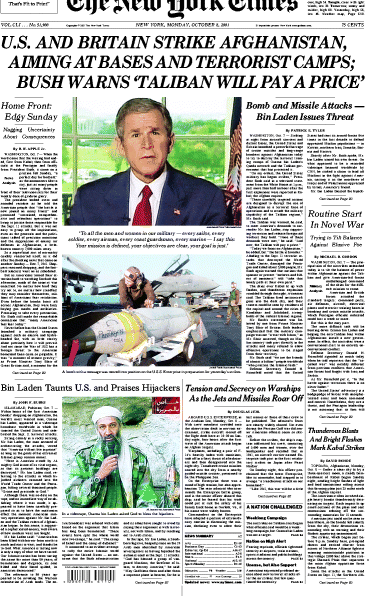
October 7, 2001 – The New
York Times carries the full story
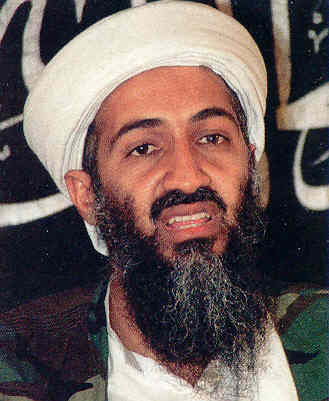
Osama Bin
Laden
|
The Move to Reconstruct Afghanistan
However, almost without giving it a second
thought, Bush began immediately to set the larger American goal in
Afghanistan as bringing national democracy to the country. Presumably
this loftier, more Idealistic goal would ennoble the American efforts
in Afghanistan. What he seemed not to realize was that this would also
open up much larger questions concerning not only American relations
with Afghanistan and the surrounding nations, but also the entire
Muslim world. It would hit the country with huge diplomatic questions
that would trouble the rest of Bush's presidency.
CIA chief Tenet was ready to go
immediately (presuming the operation to be merely taking out bin Laden
and his associates). The CIA began to pay off local Afghan supporters
to help them locate bin Laden so that CIA operatives could do their
job. But as the operation began to expand its reach from taking out the
criminal perpetrators of 9/11, to taking out all of the many al-Qaeda
training camps around the country, to taking out the entire Taliban
government, Tenet realized that the CIA needed the U.S. military's help
in carrying out its responsibilities.
Rumsfeld's Defense Department takes over the task
When asked to support the CIA, Secretary
of Defense Rumsfeld balked, refusing such support unless Tenet and the
CIA operations were put under Rumsfeld's Department of Defense (DOD).
Furthermore, the taking down of bin Laden and al-Qaeda would have to
wait until the Taliban had been defeated through the DOD's military
operations. Tenet was forced to yield, part of the frequent tension
that would characterize relationships within the Bush cabinet.
But the DOD had no immediate plans for an
Afghan operation. That would take time to develop. And the military
would not move until they were fully ready.1
Also any such plans required a lot of diplomatic preparation,
especially in getting things organized so that America's military
operations were coordinated with the local Afghan troops of the
Northern Alliance. This larger operation took time to get itself ready
for action.
Eventually (October 7th, almost a month
later) America was finally ready to go. There was a huge American and
British attack from the air on al-Qaeda training sites and Taliban
strongholds, while at the same time the Northern Alliance provided
ground troops (also assisted by U.S. special forces, mostly as liaison
personnel coordinating ground and air action), which invaded south into
Taliban territory.
But the Northern Alliance would not be
led by the highly respected Massoud, for he had been assassinated in a
well-planned operation just two days before 9/11. This had caught the
attention of CIA analysts who had been watching Afghanistan and who
sensed that something big was about to happen when Massoud was
assassinated. But they were not able to get their concerns passed on
quickly enough to put the nation's leaders on alert. Even then there
was probably no way anyone could have expected that these events in
distant Afghanistan pointed to what happened two days later on 9/11 –
just as Americans in 1941 were on to the fact that the Japanese were
planning something big, though it never occurred to them that it would
be an attack all the way across the Pacific to Pearl Harbor. [Americans
should never underestimate the abilities of their enemies to reach
deeply into their national existence to try to break them.]2
Nonetheless, the Northern Alliance
managed to hold together despite the loss of its leader. And with the
help of American and NATO air power, they were able to begin driving
back the Taliban. On November the 9th, they captured Mazar-i-Sharif,
with its key airport in the north of the country, enabling them to fly
in not only military supplies but also food for a desperately hungry
Afghanistan. Three days later they took the capital Kabul after the
Taliban fled ahead of advancing Northern Alliance forces.
With the fall of Kabul, celebrations
broke out in Washington and across America. Laura Bush, the Presidents'
wife, delivered an address to the nation describing how the Taliban was
in fast retreat and how the Afghans were rejoicing, especially the
Afghan women.
"The fight against terrorism is also a fight for the
rights and dignity of women." So it was clear. What America was
involved in was in fact the much larger goal of ridding the world of
terrorism and bringing new rights and dignity to the people of the
world.
Many of the Taliban and al-Qaeda fighters
retreated into the mountains and caves of Tora Bora, which Americans
bombed heavily on the 16th of November. Finally, CIA operatives and
Army Special Forces moved into the area. But they had hardly enough
troops to cover this huge area sufficiently. Many Taliban and al-Qaeda
fighters (including presumably bin Laden and his colleague al-Zawahiri)
simply escaped across the border into Pakistan. Other Taliban retreated
south to dig in around their political center, Kandahar, where they
were joined by more Taliban pouring in from Pakistan to join the
Taliban defense of the Pashtun south.
The clash of East-West cultures
Once again American Idealism and the hard
realities of a complex world would clash violently. Just the case of
"freeing" the women in fundamentalist Afghanistan provides a vivid
example of the complexities. Certainly equal education and equal
professional opportunities for women are well-acknowledged rights of
every woman in Western culture. But in traditional Muslim culture such
personal rights do not exist. In fact the whole Western idea of
personal rights itself is not the point of Islamic culture, which
instead teaches submission as the primary directive in life.
Everything, from children up through families, through local clans and
tribes, through anointed rulers, to Allah himself, is a construction of
correct submission. To talk of personal rights throws the whole sense
of Islamic order into confusion. In fact it is one of the major points
in the hostility of traditional Muslims against the invasion of their
culture by Western values. When Muslims hear of Westerners crusading in
their lands to bring individual rights, this touches the nerves of
devout Muslims, not just in Afghanistan but also in other parts of the
Muslim world. And in many cases, it merely makes them all the more
deliberate in their sense of opposition to the Westernizing of their
culture.
To be sure, there are many, very many, in
the Muslim world who find these Western values attractive. These are
the people that Westerners are most likely to deal with in their
contacts with the world of Islam. It is thus easy to get the impression
on the basis of this personal sampling that pro-Western attitudes are
much more prevalent in the Middle East than they actually are.
It is thus also hard, very hard, for
Americans to understand how Muslims who have lived among us in America
(as most of the 9/11 perpetrators had) could hate us as they do. Do
they not see the good in what we stand for? The answer is obviously
"no." Contact with our culture has made them all the more committed to
the idea that the evil ways of our culture must be destroyed – just as
we Americans believe that the evil ways of their culture must be
destroyed.
Thus it was that in Afghanistan, America
became drawn into a much larger challenge, one that had been brewing
for a while and was about to become monumental in size. The war on
terrorism in Afghanistan was quickly to become a war of global cultures.
1Of
course this DOD-imposed delay would give al-Qaeda plenty of time to
slip into the mountainous fastness of the Afghan Southeast – and from
there into Pakistan, where the U.S. would receive no permission
whatsoever to go in hot pursuit of al-Qaeda. In short, Rumsfeld let
al-Qaeda get away – while he now focused on taking down the Taliban, a
task that would prove to be even more difficult (actually impossible)
than the task of defeating the Viet Cong had proven to be in Vietnam.
2Very,
very ironically ... in early September of 2001 (as a just-hired history
and social studies teacher at a Christian school in Pennsylvania) I was
making this introductory point that foreign affairs was not really an
option for "Fortress America," despite the huge walls of the Atlantic
and Pacific Oceans that it seemed we could hide behind if we chose to
do so. I knew that there were enemies abroad intending to bring the
battle to America itself ... despite those oceanic walls. I cited as
the most obvious example Muslim jihadists, America-haters that I
pointed out were certainly going to make another attempt on the highly
visible and extremely valuable American national symbol, the New York
Twin Towers. However, I had no idea that this prophecy would be
fulfilled literally the very next day. My students never forgot this
act of unintended prophecy. But tragically, I lost two former
parishioners in that disaster. Thus this was indeed horribly painful
prophecy, something I would hope never to be called on to do again.

A Portable laser designator
being used by a Special Operations captain in Afghanistan directing Air Force and
Navy bombs (2001).
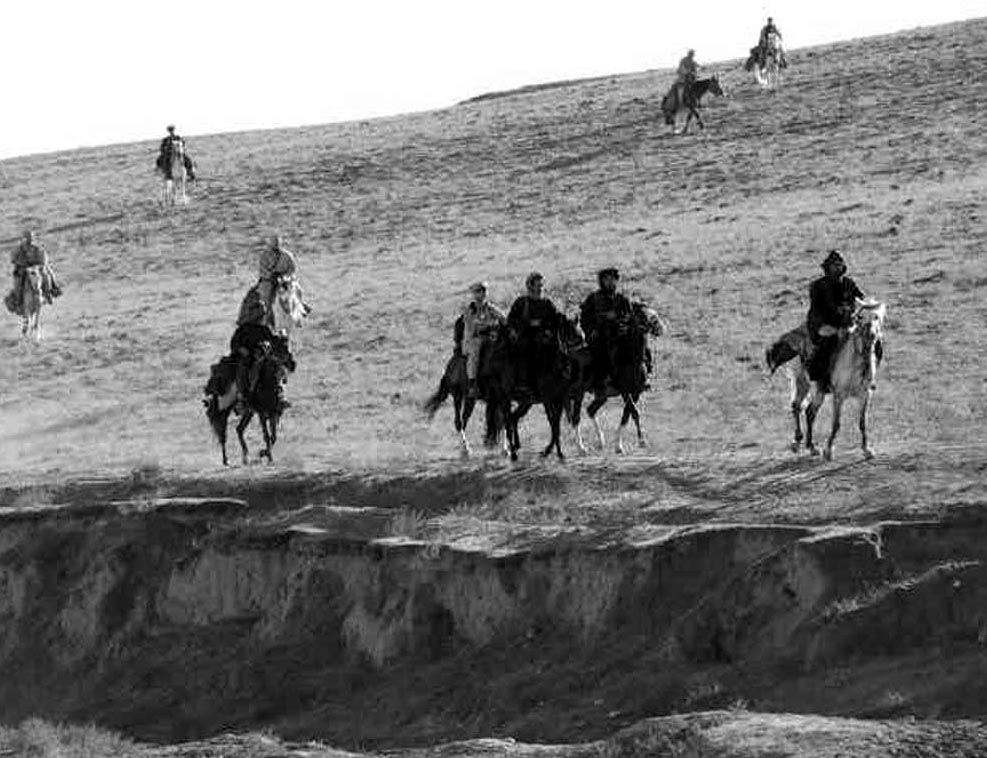
U.S. special forces troops
ride horseback as they work with members of the Northern Alliance in
Afghanistan during "Operation Enduring
Freedom" on Nov. 12, 2001
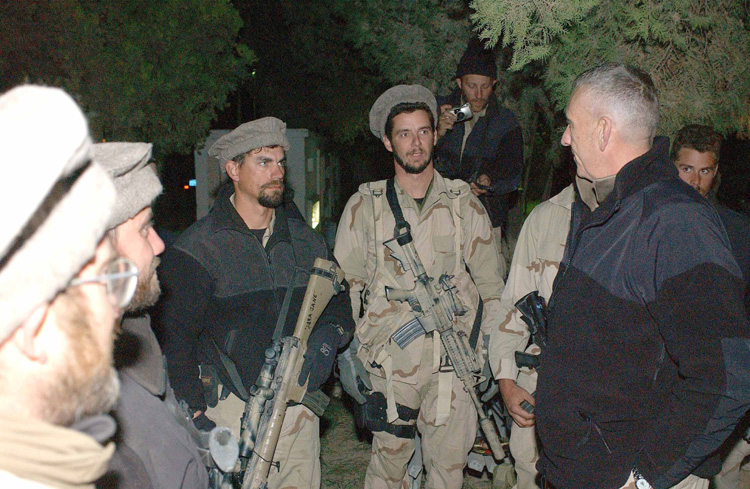
General Tommy Franks meeting
with members of Army Special Forces
The War in Afghanistan -
"Operation Anaconda"
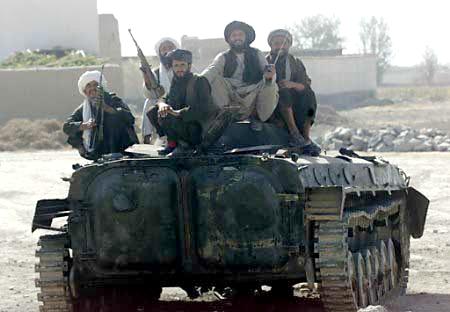
November 1 – The Taliban
in Kandahar
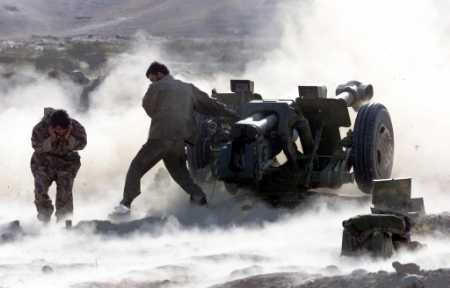
November 10 – The Northern
Alliance advances against the Taliban
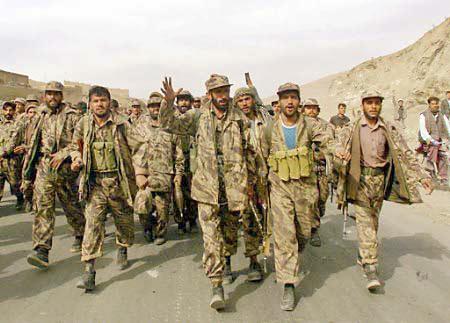
November 12 – The Northern
Alliance enters Kabul
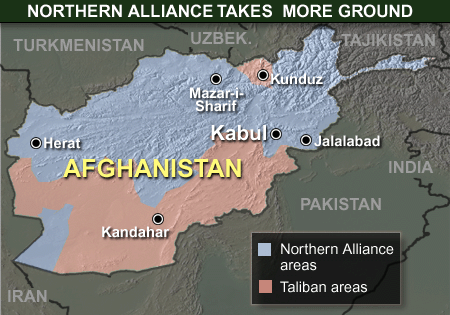
November 14 – The Northern
Alliance takes more ground
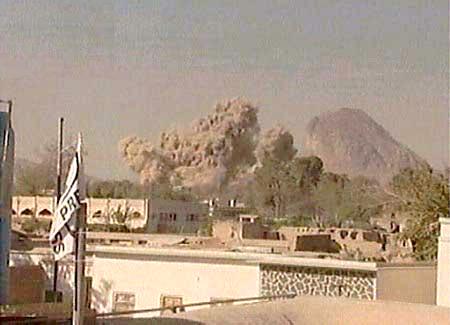
November 15 – The bombing
of Taliban positions at Kandahar
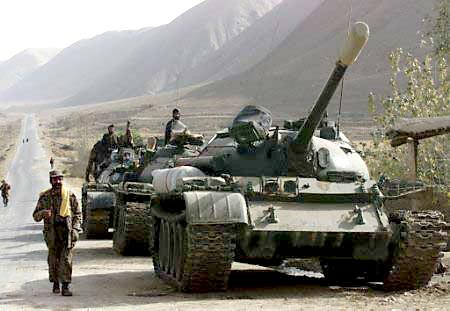
November 21 – The Northern
Alliance enters the Kunduz Province
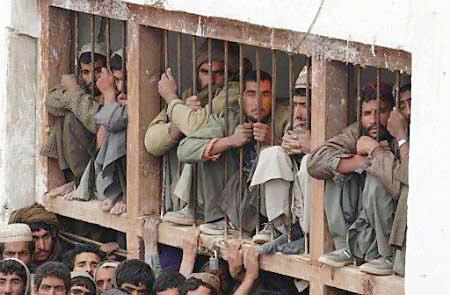
December 5 – Taliban prisoners
- Mazar
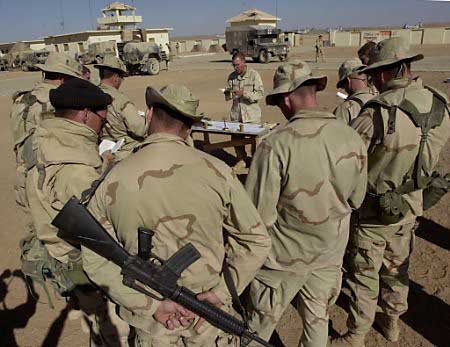
December 9 – Marine Camp
Rhino services

December 14 – To Kandahar
Airport

December 22 – Hamid Karzai
sworn in as Afghan Interim Prime Minister
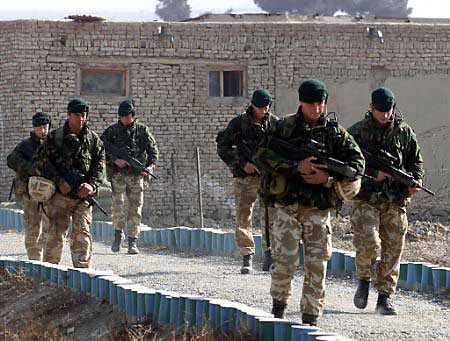
January , 2002 – British
Marines – Kabul
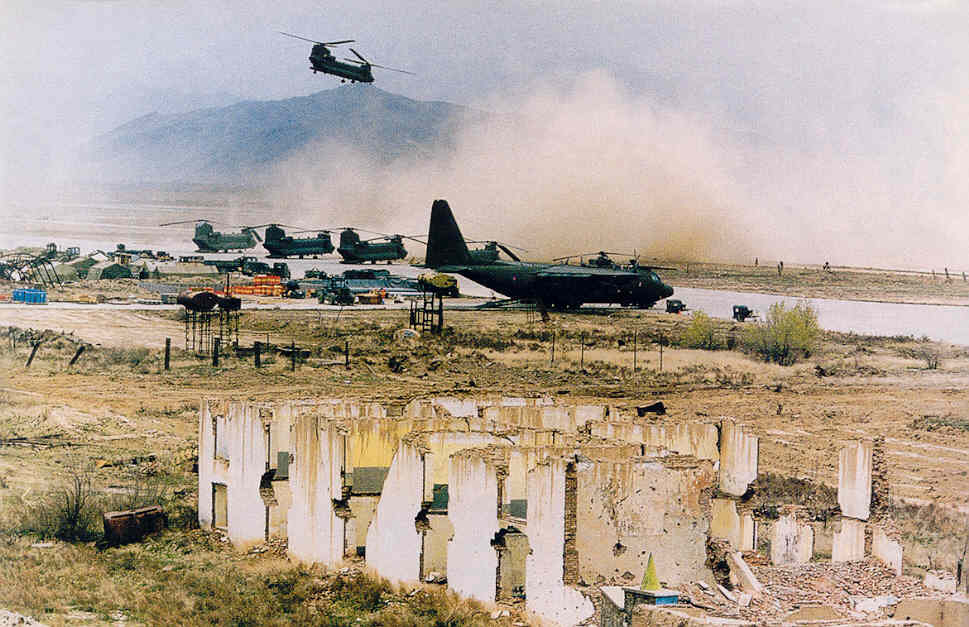
US Chinook helicopters at
Bagram Air Force Base outside Kabul in Afghanistan

March
2002
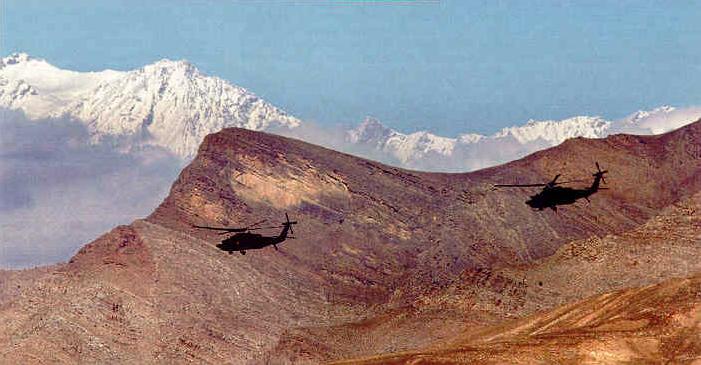
March
2002
Special Forces scouring Afghanistan
from a Chinook helicopter during Operation Anaconda – April 2002
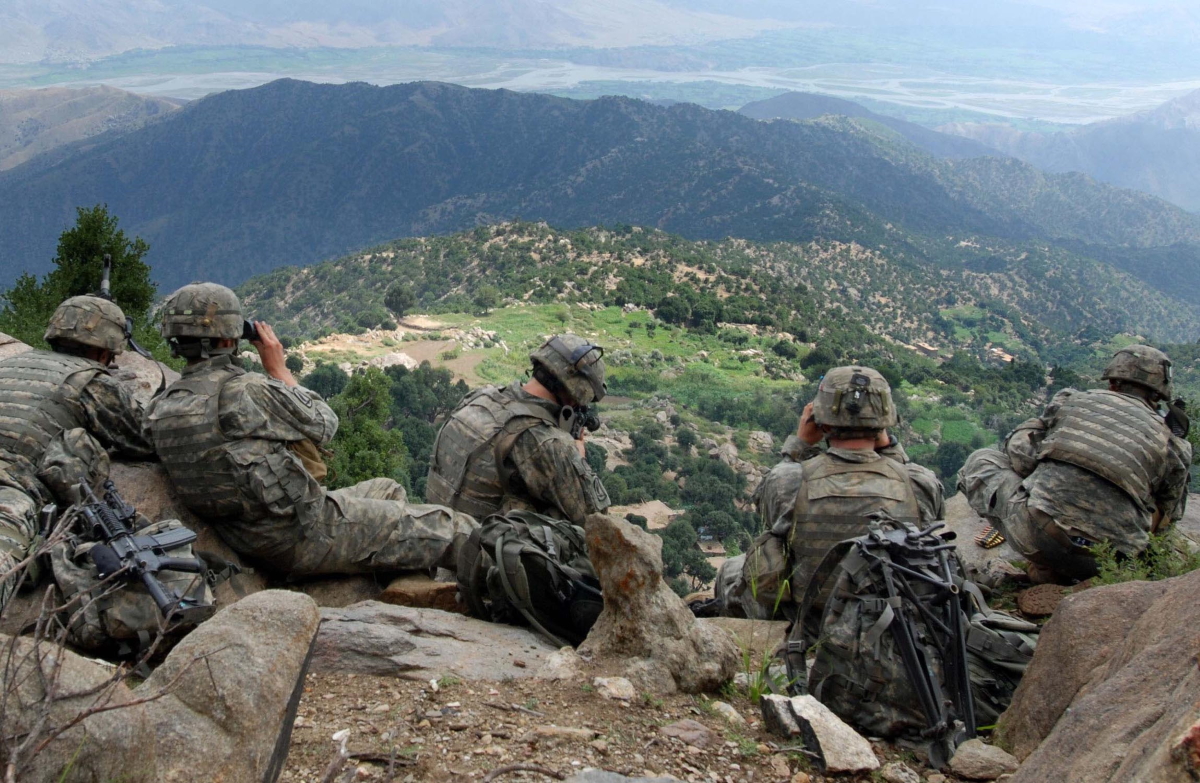
Scouts from 2nd Battalion,
503rd Infantry Regiment (Airborne), pull overwatch during "Operation Destined Strike"
while 2nd Platoon, Able Company searches a village below in the Chowkay Valley in Kunar
Province, Afghanistan
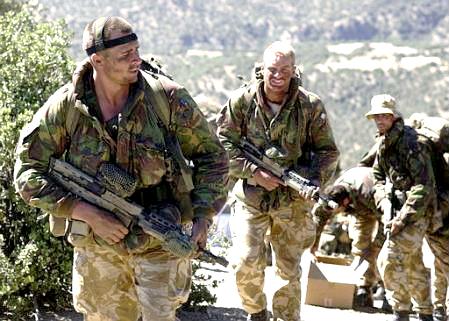
British Royal Marine Commandos
in Southeastern Afghanistan – May 2004
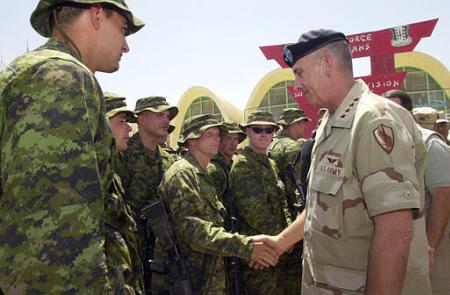
US General Tommy Franks greets
Canadian troops – Kandahar – May 2004
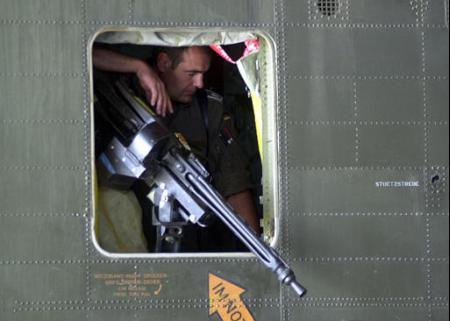
German door gunner – Kabul
airport – May 2004
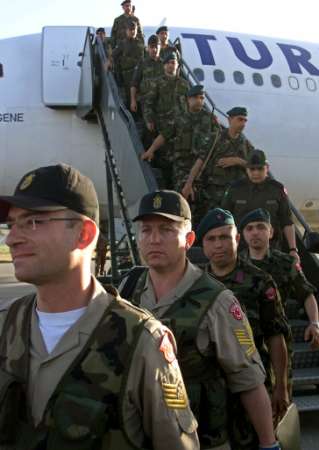
Turkish Troops arrive
at Kabul Airport to replace
British Soldiers in the
Afghan Capital – June 4, 2004
THE ATTEMPT TO "DEMOCRATIZE" AFGHANISTAN |
|
In December a select group of Afghans met in
Bonn, Germany, under U.N. sponsorship to put together an Agreement
providing for a provisional authority and a constitution drafting
committee. Hamid Karzai, of a well-respected Pashtun political and
diplomatic family background, and backed personally by America, was
selected to serve a 6-month term as chairman of a Transitional
Administration. The Bonn Agreement also called for the convening of a loya jirga
(grand council) which by Afghan tradition was required to select any
Afghan leader. A loya jirga of June 2002 in Kabul reappointed Karzai as
head (this time as its president) of the Transitional Administration
for a term of two years. The title was mostly honorific since there was
little direct government outside of the capital itself but only loose
arrangements or alliances with the many Afghan warlords who were in
fact the real leaders here and there around Afghanistan. But Karzai did
an excellent job of keeping this rather traditional Afghan political
system functioning fairly effectively (that had been the pattern by
which the Afghan Shah had once "governed" the country).
There seemed little more that could be done against bin Laden, who had
obviously slipped into Pakistan – where the Pakistani government
refused to allow American or NATO troops into their country in pursuit
of al-Qaeda. Pakistan allowed supplies for American and NATO troops to
pass through its territory on its way to Afghanistan. But the
Pakistanis were unbending in their refusal to allow U.S. troops on
Pakistani soil. In fact, it seemed that at times elements of the
Pakistani government, military, and intelligence agency (ISI) were
still actively supporting the Taliban. There seemed to be no way to get
either bin Laden or the remainder of al-Qaeda as long as Americans
could not enter Pakistan – and as long as Pakistan played a confusing
game of conflicting political and diplomatic loyalties.
In 2004 there were actually national elections
held in Afghanistan, at least in the parts of the country not still
under Taliban control. And Karzai was decisively elected over his 22
opponents, with victories in 21 of the 34 provinces. What America and
the West understood as "democracy" had finally come to Afghanistan ...
or so it appeared anyway.
But by this point, Bush had shifted his
priority from Afghanistan to a matter of greater interest to the
president: Iraq. For reasons known only to Bush, he had by this time
taken on the goal of ridding the world of Iraq's dictator, Saddam
Hussein – and bringing Iraq to "democracy" as his primary foreign
policy goal. He would pour the bulk of America's military assets into
this new anti-Saddam campaign. This left the situation in Afghanistan
now very problematic.
Thus with the shifting of the diplomatic focus
west toward Iraq, the Taliban were clearly able to make a political
comeback in Afghanistan – by 2006 able to once again take over villages
that they had been chased from, terrorizing the local population back
into submission.
At this point there just were not enough
American and NATO soldiers in Afghanistan to protect the local
population from a Taliban return. America and its allies would send out
military missions to retake villages from the Taliban. Then after a
short while these Western troops would have to withdraw because they
were needed elsewhere. And then the Taliban would return – and execute
any who had helped the Westerners. After a while the Afghans simply
asked the Americans not to "help" them. This was Vietnam all over again
– although even less likely to find any success as things now stood.
Recent wars have been whole peoples against other peoples, cultures
against cultures, popular worldviews violently contending with other
worldviews. Such struggles have been characterized not by the matching
of uniformed armies against uniformed armies, but by the participation
in one form or another of whole populations – men, women, and children – in
the violence of war. Vietnam was a clear example of this problem –
where American troops became easily visible targets at the same time
that Americans were never sure who were the proper targets among the
Vietnamese. Friendly smiles could turn into murderous design once the
backs of American soldiers were turned. To be sure there were
Vietnamese supporters of the American presence. But how could Americans
tell the difference between sincere and faked friendliness? Mistakes
were made – huge mistakes at times – especially when the frustration
level of American troops turned explosive.
The American Department of Defense or Pentagon
never really worked out a solution to this problem. Consequently, the
problems in Afghanistan were presenting themselves in the same format
as the Vietnam war. If the Taliban presented themselves in some kind of
battle array, they were as good as dead in American gun sights. But
when they instead moved in and out of the local population (terrorizing
the locals to make sure that no locals identified these Taliban to the
Western troops) it was very difficult to hit them militarily.
|
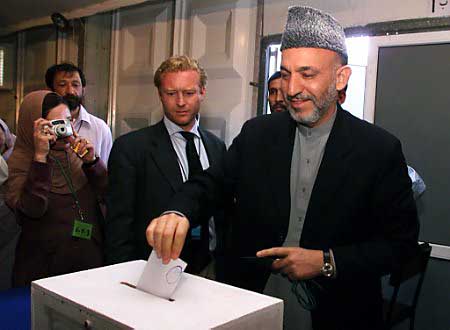
June 13, 2002 – Hamid Karzai wins
the elections for President of the Afghan Loya Jirga
(Parliament)
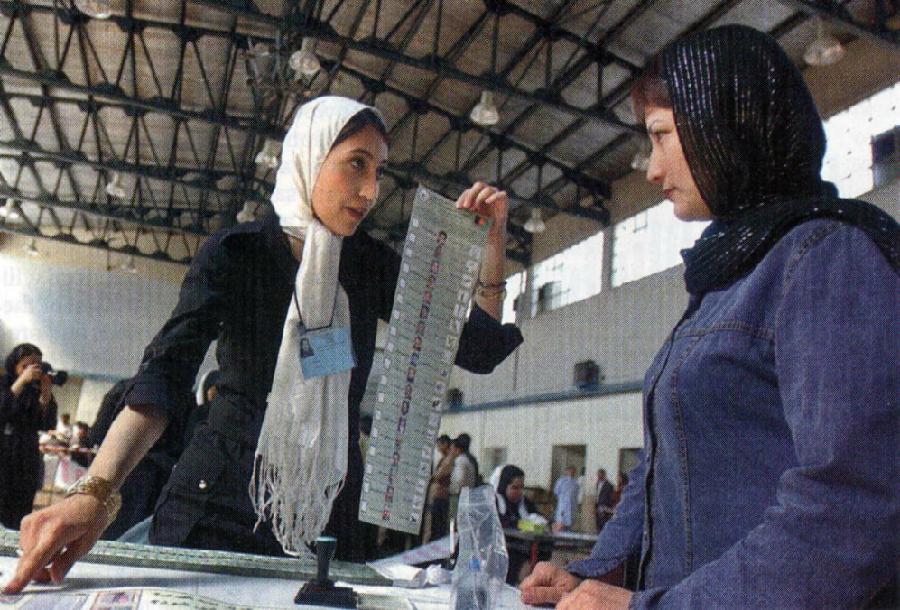
An Afghani voter being instructed
on how the voting works
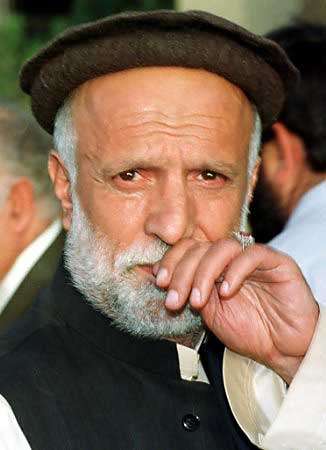
July 6, 2002 – Afghanistan
Vice President Haji Abdul Qadir and his driver are assassinated in a Kabul
Street during daring daytime attack
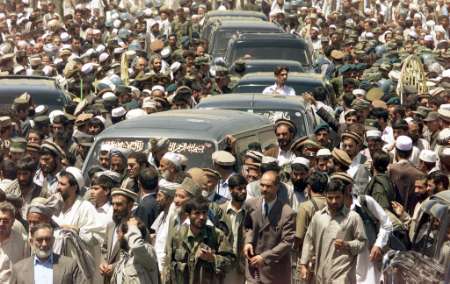
July 7 – His funeral in
Kabul
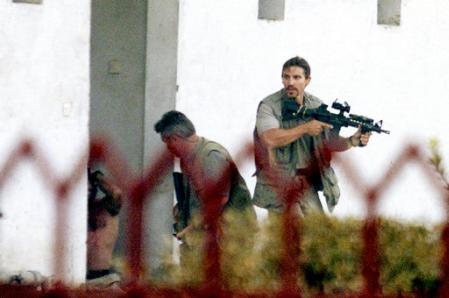
September 5 – US Special
Forces secure area after attempted assassination of Karzai
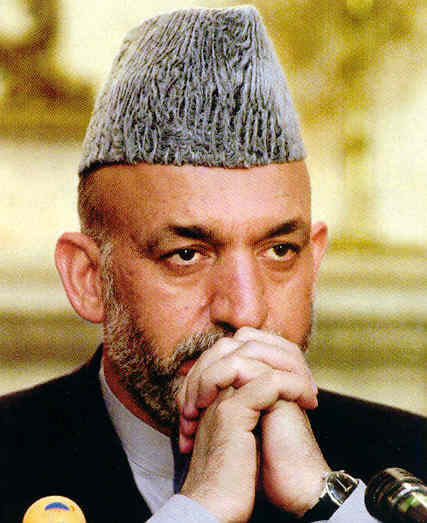
Hamid Karzai – Afghan
President 
Afghan President Hamid Karzai
meets with tribal leaders from the Kunduz province
TAKING MORE EXTREME MEASURES |
|
The CIA had its methods, moving as it did in the
"dark areas" of conflict, using bribes, spies and assassins to take out
the enemy. This was fairly effective in this kind of conflict,
especially since only the leadership among the enemy needed to be taken
out in order to keep the enemy at bay. But of course these kinds of
procedures were exactly what America's sense of the "rules of war"
forbade.
To further complicate things, the field
of battle was no longer off in some distant field such as Vietnam.
Certainly much of the action was in Afghanistan. But it was also in
Europe and even in America itself. The enemy was among us – but could
not be easily distinguished from friendly Muslims living among us.
They knew who they were of course. And
thus finding out what they knew became important in identifying the
enemy so that we could fight them – and not just wait for them to hit
us. But getting such information, which in fact given the nature of the
conflict had to be a key part of the war strategy, was not going to
please those who felt that we should remain the model of "civilized"
warfare. And thus a deep conflict over information-gathering tactics
among the Muslim terrorists arose within our own cultural circles just
as it had during the Vietnam War.
Bush attempted to get clarification and ultimately full legal
authorization from our own lawmakers in Congress and – given the
legislative ambitions of the nation's federal judiciary – that branch
of government as well (although, given the ideological diversity of
these judicial ambitions, much trickier to negotiate). At first, it was
fairly easy to find political support for an aggressive
national-security policy. But with time this support became much more
difficult to maintain.
The USA PATRIOT Act of 2001
Within little more than a month after
9/11, Congress was quick to extend extensive powers to the President as
the nation's Commander in Chief, enabling him to take a wide range of
actions designed both to protect the nation from any further assaults
of the likes of 9/11 and to go after America's enemies abroad. The
title of this legislation is lengthy and yet very explanatory of its
nature: the "USA" portion stands for "Uniting and Strengthening
America"; the "PATRIOT" portion stands for "Providing Appropriate Tools
Required to Intercept and Obstruct Terrorism." Basically the Act gave
precise, but broader definition to the term "terrorist"; it gave
various government agencies greater power to uncover and track
terrorist communications and the movement of their funding through the
international banking system; it gave federal authorities wider powers
to act to detain and deport suspected terrorists; and it gave these
authorities the right (through the use of National Security Letters or
NSLs) to demand that organizations suspected of involvement in
terrorism turn over their records and data to the federal authorities.
At the time, the anger against al-Qaeda
and their Taliban hosts was so deep that there was almost unanimous
support in Congress for the legislation. But as time went along and no
new attacks were made on the country, as the Taliban had been chased
from power into the wastes of the Hindu Kush mountains, and thus as the
sense of immediate danger subsided, civil libertarians (such as the
ACLU) began to speak out against the Act. The act had been put under a
"sunset" provision, terminating it as of the end of 2005 – unless it
was extended by a new act of Congress. As that time approached the
controversy grew hot. But in the end Congress extended the Act.
But the
federal courts also got into the debate (of course!), striking down many of the NSL
provisions. Once again, the federal courts took on
the role as the supreme, as well as the untouchable, legislative branch of
the U.S. government.
The United States Department of Homeland Security
Along with these provisions for the
empowerment of the federal authority to act swiftly and deeply against
terrorism directed against America went the administrative
reorganization of the federal agencies immediately involved in the
enforcement of these provisions. Some twenty-two separate governmental
agencies were merged into a single administrative department, the
Department of Homeland Security, in early October of 2001, in an effort
to cut through the maze of different agencies not all that much in
touch with each other previously. There had been a huge breakdown in
communications among various agencies responsible for this or that
aspect of domestic national security. Had there been better
inter-service communication, 9/11 might have been prevented. The
Department of Homeland Security was created to make sure that this did
not happen again.
The Guantanamo Bay detention camp
One more piece of the picture with
respect to the changes in American life brought on by this war on
terror occurred as thousands of Taliban and al-Qaeda were captured in
the first months of the war in Afghanistan. This presented the quite
large problem of what to do with the captives. It was finally decided
to send hundreds of them to the U.S. naval base at Guantanamo Bay in
Cuba, where they would come under military law rather than civil law
(and extensive civil protections), where the activist federal judiciary
had no jurisdiction. There they could also be interrogated in order to
get information on the whereabouts of al-Qaeda operatives, especially
bin Laden and Zawahiri.
Some of the Bush cabinet were squeamish
about the methods used to get information and argued heatedly over the
issue. One of the ways out was what came to be called "rendition," that
is, sending Taliban and al-Qaeda prisoners to another country less
squeamish about using torture to get information, usually Egypt, where
the government had a deep dislike of Islamic fundamentalism (Muslim
fundamentalists had assassinated Egyptian President Sadat in 1981 and
had on numerous occasions tried to assassinate his successor, President
Mubarak). Of course this did not solve the moral questions involved by
simply passing on responsibility to someone else.
But the problem remained. Without
knowledge about the plans of those who wanted to kill Americans, we
really were defenseless. America had not asked for this kind of
warfare. But insurgency left America with few options if it was going
to protect itself. And with time, failure to do so would only worsen
the dangers. Someday weapons of mass destruction (terrible chemical or
even worse biological, or even eventually nuclear, weapons) would fall
into the hands of terrorists. Should that happen Americans would find
themselves living in a very sorry world.
Meanwhile the international community
(joined by Liberals in Congress and in the U.S. press corps) began to
complain loudly about the torture of prisoners ("waterboarding" being a
particular object of criticism) to get this vital information.
But the Bush Administration remained
unmoved. As Bush saw things, he had a job to do. There was a war
against a dangerous enemy to be won. And it could be won only through
these unwanted means brought on by the way the enemy himself chose to
fight.
|
Another aspect in the changing world of
international war and diplomacy was the dangerous proliferation of
nuclear weapons, and how it played into the struggle America was having
with the world of Islam. In 1999, just before Bush came to office,
America had cut off all further official American economic and military
aid to Pakistan, one of its supposed long-time allies. This was the
result of the discovery of the fact that Pakistan had been developing
its own nuclear weapons in violation of promises not to go there –
though India had also been doing the same, and would suffer the same
cutoff of American assistance as a result. Worse, Pakistan had been
doing so in conjunction with a group of other countries, notably China,
but also the dark, dark country of North Korea. Suspicions also were
that Pakistan was working with the rogue state Libya, the bitter Iraqi
enemy Saddam Hussein, and the country dedicated to the death of America
as the Great Satan, the Islamic Republic of Iran. And behind this all
seemed to be the one person considered by all Pakistanis as their
greatest scientist and national hero, Dr. Abdul Qadeer (A.Q.) Khan, and
his organization, Khan Research Laboratories (KRL).
In 1974 India had exploded its first
nuclear device, making it the sixth nuclear power in the world.
Pakistan (India's arch-rival) had also been working on developing its
own nuclear capacity. But after the Indian testing, Pakistan's Prime
Minister Bhutto felt the need to push Pakistan's own program ahead more
forcefully. Pakistan began developing a two-pronged approach to the
matter: the development of a plutonium-based bomb under the direction
of Munir Ahmad Khan and the development of a uranium-based bomb under
the direction of A.Q. Khan. Both directors had studied and worked
extensively in Europe or America and were able to bring back their
expertise to Pakistan to push the program ahead.
Then on May 11 and 13, 1998, India went
through a second series of nuclear tests. Surprisingly two weeks later
(28 May), Pakistan exploded its own nuclear uranium device and two days
after that its first plutonium device. The quickness by which Pakistan
was able to answer the Indian tests immediately raised suspicions that
Pakistan had been receiving last-minute direct help in finalizing its
own nuclear program, most likely from China (a major rival to India in
Asia).
America imposed sanctions on both India
and Pakistan, and openly blamed China for helping Pakistan. Americans
had long been suspicious that China and Pakistan (and North Korea) were
working together on nuclear weapons development. Evidence of such
pushed America to end its economic and military aid to Pakistan in
1999. But this seems to have only pushed Pakistan even deeper into its
nuclear relationship with China.
The West's growing concern about Pakistan
America and the West watched Pakistan
closely because of its status as a nuclear power. Even more than
Russia, Pakistan was viewed as a country vulnerable to a potential loss
of control over its nuclear materials. With Islamic fundamentalism
growing ever stronger in Pakistan, fear in the West grew rapidly about
the dangers the world might find itself in if some of that material
found its way into the hands of Muslim fanatics.
Then
it came to light that Dr. A.Q. Khan
and his research organization KRL had in fact been offering the sale of
nuclear technology to Iraq, North Korea, Iran and Libya, even to
al-Qaeda and possibly the Taliban. In late October 2001 three KRL
nuclear scientists close to Khan were arrested as being
pro-Taliban.
Then evidence uncovered in an investigation in 2003 and early 2004
pointed fairly clearly to the fact that Iran's uranium enrichment
facility came from Khan's plans (which he apparently had sold to Iran
for tens of millions of dollars). Pakistan's former Army Chief of
Staff, General Mirza Aslam Beg was also involved in the Iran
sale. In
December 2003 two more KRL scientists were arrested. In that same
month
Libya agreed to give up its nuclear ambitions. Inspectors traced
Libya's program back to the Pak 1 models of Khan's gas
centrifuge.
Three Swiss associates of Khan were arrested by Interpol.
Investigations conducted by the Pakistani government revealed a complex
underground tangle involving agents from all around the world, Dutch,
Germans, Malaysians, arms merchants from Dubai and Niger, even an
Israeli arms merchant.
In 2004 Khan, confessed that he had given
Iran, Libya, and North Korea his nuclear plans. However, he later
claimed that Pakistani President Musharraf had pressured him at that
point into making what was indeed a false confession, largely to
appease America, which was pressuring Musharraf to do something about
Khan.
Pakistani President Musharraf walked a delicate line between pressures
from America to cut off Khan and pressures from the Pakistanis who
viewed Khan as something of a national hero, similar to the complex
position in which also America found itself in that part of the world.
|
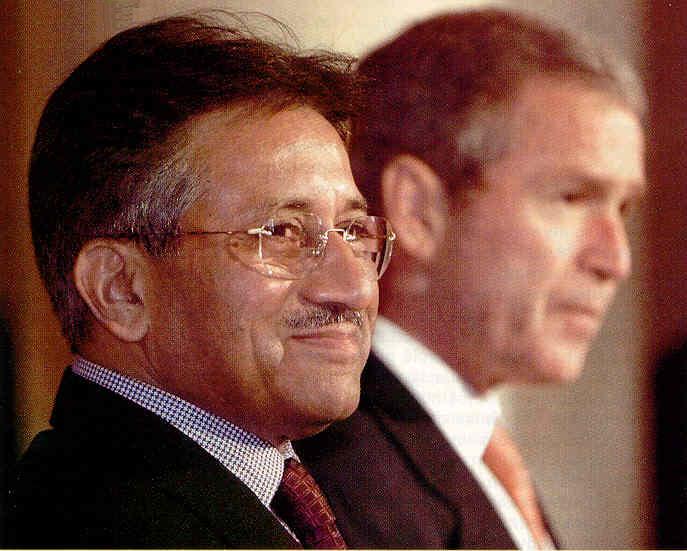 Pakistani President Gen.
Pervez Musharraf and Bush – March 2002
Pakistani President Gen.
Pervez Musharraf and Bush – March 2002
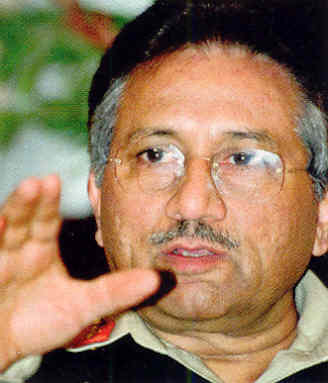
Gen. Pervez Musharraf, President
of Pakistan
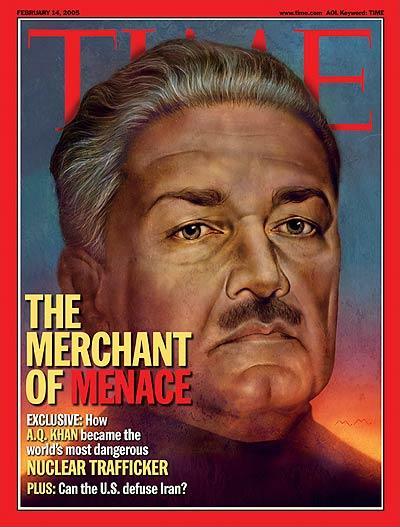
MEANWHILE, BUSH ATTEMPTS TO LINE UP SUPPORT IN THE REST OF THE WORLD |
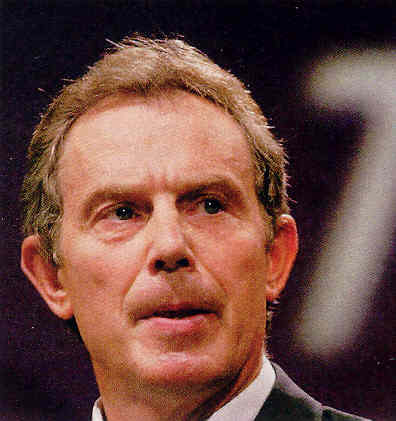
British Prime Minister Tony
Blair – a staunch American ally
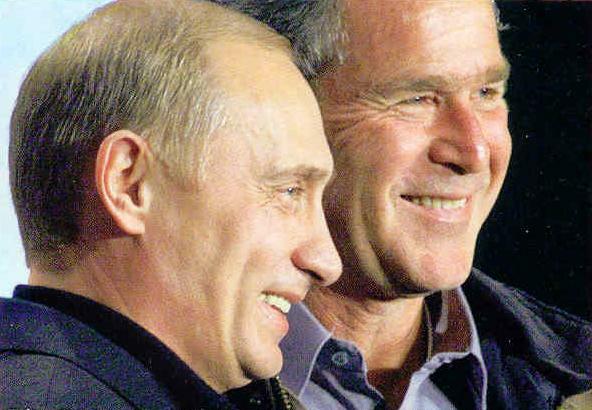
Putin and Bush – Moscow
summit – May 2002
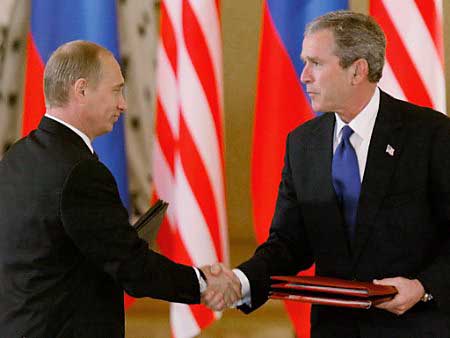
Putin and Bush sign a nuclear
treaty at the Kremlin – May 24, 2002
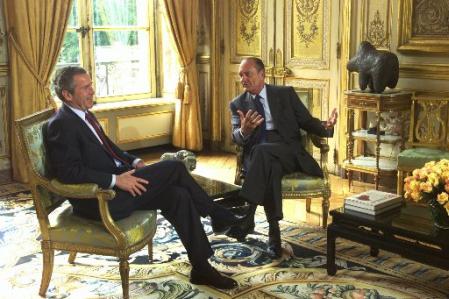
Bush and Chirac at the Elysee
Palace – Paris – May 26, 2002
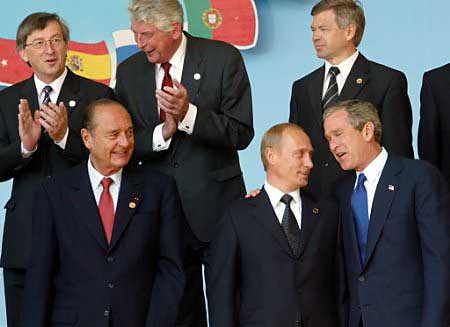
Chirac, Putin and Bush and
other NATO leaders – Rome – May 28, 2002
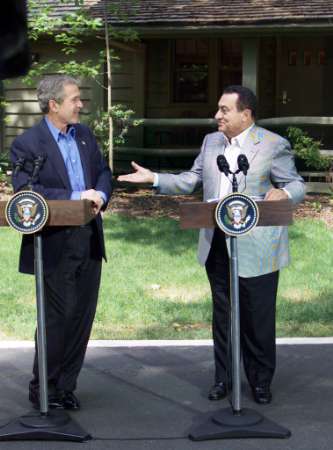
Bush meets with Egyptian
President Mubarak at Camp David – June 8, 2002 (two days later Bush meets
with Israeli PM Ariel Sharon)
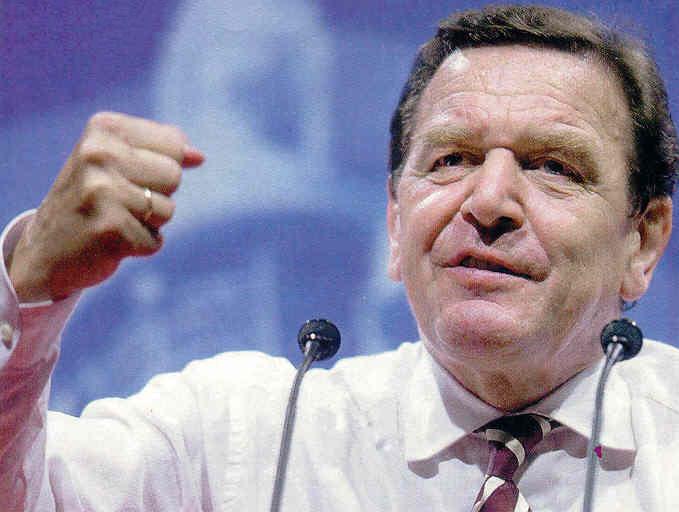
Gerhard Schröder – German
Chancellor (Socialist)

Go on to the next section: Bush's "Democratic Nation-Building" in Iraq
 Miles
H. Hodges Miles
H. Hodges
| | | | |


 The evil hand of Islamic fundamentalism
The evil hand of Islamic fundamentalism The world pays tribute to those who died
The world pays tribute to those who died Going after al Qaeda ... and the Afghan
Going after al Qaeda ... and the Afghan The attempt to "democratize"
The attempt to "democratize" Bush attempts to line up support in the
Bush attempts to line up support in the




























































